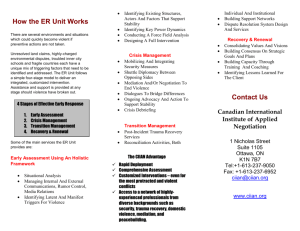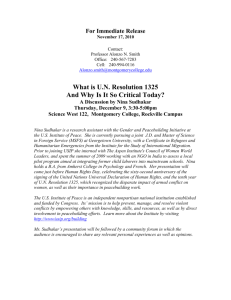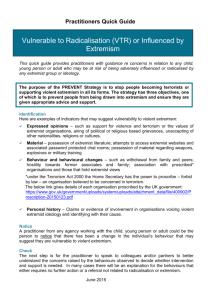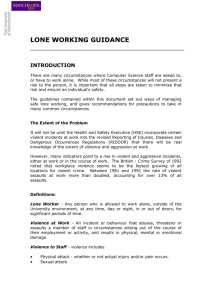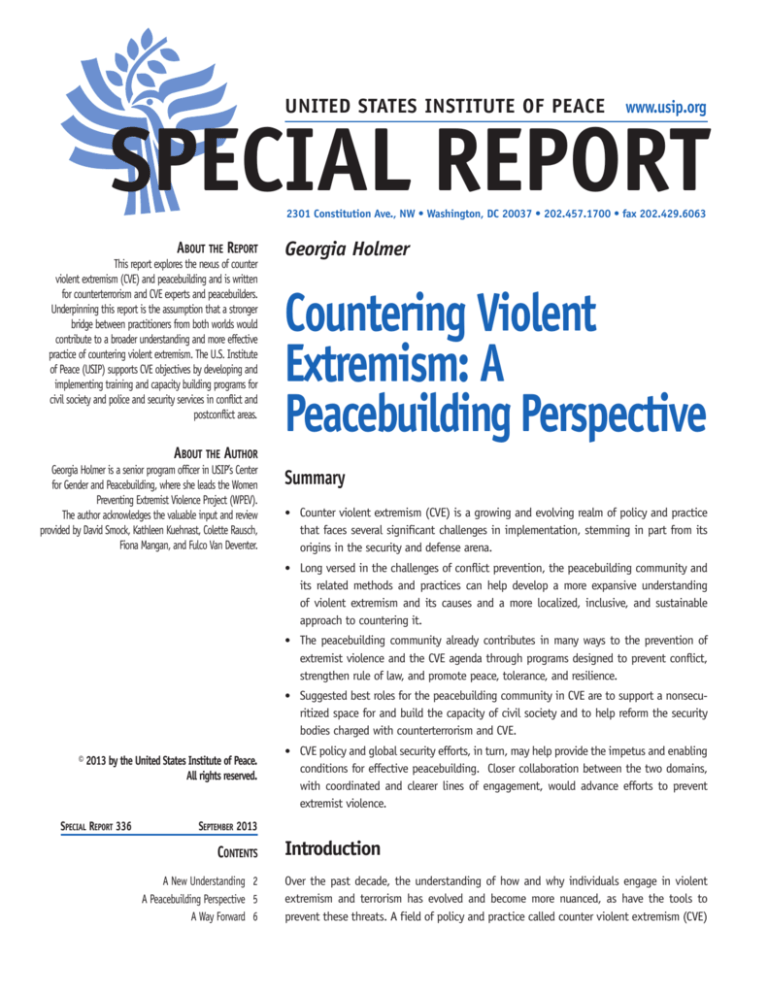
United States Institute of Peace
www.usip.org
SPECIAL REPORT
2301 Constitution Ave., NW • Washington, DC 20037 • 202.457.1700 • fax 202.429.6063
About the Report
This report explores the nexus of counter
violent extremism (CVE) and peacebuilding and is written
for counterterrorism and CVE experts and peacebuilders.
Underpinning this report is the assumption that a stronger
bridge between practitioners from both worlds would
contribute to a broader understanding and more effective
practice of countering violent extremism. The U.S. Institute
of Peace (USIP) supports CVE objectives by developing and
implementing training and capacity building programs for
civil society and police and security services in conflict and
postconflict areas.
About the Author
Georgia Holmer is a senior program officer in USIP’s Center
for Gender and Peacebuilding, where she leads the Women
Preventing Extremist Violence Project (WPEV).
The author acknowledges the valuable input and review
provided by David Smock, Kathleen Kuehnast, Colette Rausch,
Fiona Mangan, and Fulco Van Deventer.
Georgia Holmer
Countering Violent
Extremism: A
Peacebuilding Perspective
Summary
• Counter violent extremism (CVE) is a growing and evolving realm of policy and practice
that faces several significant challenges in implementation, stemming in part from its
origins in the security and defense arena.
• Long versed in the challenges of conflict prevention, the peacebuilding community and
its related methods and practices can help develop a more expansive understanding
of violent extremism and its causes and a more localized, inclusive, and sustainable
approach to countering it.
• The peacebuilding community already contributes in many ways to the prevention of
extremist violence and the CVE agenda through programs designed to prevent conflict,
strengthen rule of law, and promote peace, tolerance, and resilience.
• Suggested best roles for the peacebuilding community in CVE are to support a nonsecu-
ritized space for and build the capacity of civil society and to help reform the security
bodies charged with counterterrorism and CVE.
© 2013 by the United States Institute of Peace.
All rights reserved.
Special Report 336
• CVE policy and global security efforts, in turn, may help provide the impetus and enabling
conditions for effective peacebuilding. Closer collaboration between the two domains,
with coordinated and clearer lines of engagement, would advance efforts to prevent
extremist violence.
September 2013
Contents
A New Understanding 2
A Peacebuilding Perspective 5
A Way Forward 6
Introduction
Over the past decade, the understanding of how and why individuals engage in violent
extremism and terrorism has evolved and become more nuanced, as have the tools to
prevent these threats. A field of policy and practice called counter violent extremism (CVE)
About the Institute
The United States Institute of Peace is an independent,
nonpartisan institution established and funded by Congress.
Its goals are to help prevent and resolve violent conflicts,
promote post-conflict peacebuilding, and increase conflict
management tools, capacity, and intellectual capital worldwide. The Institute does this by empowering others with
knowledge, skills, and resources, as well as by its direct
involvement in conflict zones around the globe.
Board of Directors
J. Robinson West (Chair), Chairman, PFC Energy,
Washington, DC • George E. Moose (Vice Chair), Adjunct
Professor of Practice, The George Washington University,
Washington, DC • Judy Ansley, Former Assistant to the
President and Deputy National Security Advisor under
George W. Bush, Washington, DC • Eric Edelman, Hertog
Distinguished Practitioner in Residence, Johns Hopkins
School of Advanced International Studies, Washington,
DC • Joseph Eldridge, University Chaplain and Senior
Adjunct Professorial Lecturer, School of International
Service, American University, Washington, DC • Stephen
J. Hadley, Principal, RiceHadleyGates, LLC, Washington,
DC • Kerry Kennedy, President, Robert F. Kennedy Center
for Justice and Human Rights, Washington, DC • Ikram
U. Khan, President, Quality Care Consultants, LLC., Las
Vegas, NV • Stephen D. Krasner, Graham H. Stuart
Professor of International Relations at Stanford University,
Palo Alto, CA • John A. Lancaster, Former Executive
Director, International Council on Independent Living,
Potsdam, NY • Jeremy A. Rabkin, Professor of Law,
George Mason University, Fairfax, VA • Judy Van Rest,
Executive Vice President, International Republican Institute, Washington, DC • Nancy Zirkin, Executive
Vice President, Leadership Conference on Civil
and Human Rights, Washington, DC
Members Ex Officio
John Kerry, Secretary of State • Kathleen Hicks, Principal
Deputy Under Secretary of Defense for Policy • Gregg F.
Martin, Major General, U.S. Army; President, National
Defense University • Jim Marshall, President, United States
Institute of Peace (nonvoting)
has emerged that focuses on countering the pull of terrorist recruitment and influence
by building resilience among populations vulnerable to radicalization. As the domain of
CVE continues to mature and expand, moving further upstream to address root causes of
extremist violence, much of the work touches the realm of peacebuilding.
Peacebuilders, through their broader agenda of conflict prevention, also focus on
countering extremist violence. Violent extremism is a driver of conflict, and violent
extremists are often spoilers in peacebuilding efforts. Peacebuilding and CVE work
increasingly intersect, though approaches and practice in the two domains often differ.
This report bridges that divide by exploring complementary spaces and the limitations in
their overlap.
A New Understanding
Counter violent extremism is a realm of policy, programs, and interventions designed to
prevent individuals from engaging in violence associated with radical political, social,
cultural, and religious ideologies and groups. Whether it exists as a subset or evolution
of counterterrorism (CT) policy and practice depends on where one sits. In the same way
that the legal and policy definitions of terrorism vary across U.S. agencies and international organizations—and reflect the mandate, scope, and role of those entities in
countering it—the term violent extremism means different things in different contexts.1
Significantly, CVE emerged from and does, for the most part, remain parked—programmatically and conceptually—in the international and national security policymaking
community as part of a broader effort to counter terrorism.
The shift to prevention began as a concept after 9/11, spurred in large part by the
changing nature of terrorism and the advent of decentralized actors and self-radicalized
small groups and lone wolves. This affected the ways in which the international community
worked to counter the threat but also increased awareness that the pursuit and apprehension of terrorists was—and is—a different functional problem than the prevention of new
recruits. The shift in emphasis to CVE engagement was also guided by the realization among
policymakers that some CT approaches had indeed exacerbated the threat and added new
recruits to the ranks of terrorist groups and movements.
To a large degree, and somewhat symbiotically, CVE policy has kept pace with an
expanded understanding of how and why individuals become involved in extremist violence.
Over the past ten years, significant social science research has advanced a sophisticated
analytic framework of the dynamics of radicalization. This research has led us past simplistic explanations for terrorism, and we now understand radicalization as a fluid, nonlinear,
highly individualized process (see figure 1). The process reflects the interplay of drivers on
several levels:
• push factors that include structural conditions, such as poverty, and grievances, such
as lack of access to political processes or justice;
• individual psychological and emotional characteristics, such as need for belonging,
dignity, meaning, or revenge, or the continuation of cycles of violence brought on
by chronic conflict;
• the influence of socialization and group dynamics by family, peers, and schools; and
The views expressed in this report do not necessarily
reflect the views of the United States Institute of Peace,
which does not advocate specific policy positions.
To request permission to photocopy or reprint materials,
e-mail: permissions@usip.org
• the pull of active recruitment to include extremist messaging that inspires violence.2
What leads a young man in northern Nigeria to join Boko Haram3 or a teenager in
Kyrgyzstan to spend time with Hizb ut-Tahrir4 or a young woman to join the ranks
of the FARC in Colombia5 are a unique and highly contextual set of circumstances,
2
USIP.ORG • SPECIAL REPORT 336
Figure 1. Dynamics of Radicalization
Group dynamics and relationships
P
U
S
H
Structural
conditions
and
psychologicalemotional factors
Active
recruitment
and
extremist
messaging
P
U
L
L
Increased vulnerability to engagement
in violent extremism
grievances, and issues. And though these stories, pathways, or trajectories toward
extremist violence can be carefully analyzed and understood in retrospect, no models
of radicalization are predictive.6 There is no way to determine whether an individual
in certain circumstances, with a certain disposition, with certain relationships, and
exposed to certain ideas will end up engaged in violence. It is only possible to gauge
vulnerability to this likelihood. This reality is particularly problematic for those
charged with detecting and preventing terrorism and violent extremism.
Although the radicalization process is highly contextual, many of the push factors that
relate to an individual’s internal traits and psychological motivations can be universally
understood.7 Jerrold Post, Marc Sageman, and others have identified common socialpsychological motivations for participating in terrorist groups and movements, such as a
need for belonging and validation.8 Others have pointed to emotional drivers, such as a
desire for revenge and responses to perceived humiliation, especially in the case of suicide
attacks.9 A sense of thrill seeking and adventure also can play a part in pushing others
toward engagement in violence.10 In this way, understanding the dynamics of radicalization requires an appreciation for human psychology.
Underscoring this more nuanced concept of radicalization is an acknowledgment that
there is not a direct causal relationship between radical ideas and extremist violence. Some
scholars even posit that not all violent extremists are radical in their belief system, in that
some have only a superficial adherence to the ideology believed to “inspire” the violent
acts.11 This is an important perspective that suggests that focusing on “countering the
narrative” of extremists is only part of the solution.
This thinking is manifested in the policy shift to a “whole-of-government approach”
to countering violent extremism and is reflected in the “development and security nexus”
debate.12 CVE practice has expanded to include a spectrum of interventions that range
from working to counter the narrative of terrorist recruitment messaging to development
projects designed to mitigate the more structural causes that make an individual vulnerable to recruitment. CVE can now be best characterized as a rapidly growing and evolving
international community of practice.
However, the translation of CVE policy, as currently conceptualized, into effective practice continues to face several significant interrelated challenges:
USIP.ORG • SPECIAL REPORT 336
3
Though stories, pathways, or
trajectories toward extremist
violence can be carefully
analyzed and understood
in retrospect, no models of
radicalization are predictive.
Most governments distinguish
between criminal violence and
violence rooted in or associated
with an extremist ideology.
… In the real world, terrorist
and criminal activity are often
closely intertwined.
The problem of definition: addressing the grey. The national and international
government entities charged with developing and implementing CT and CVE policy
and protecting the public from security threats are appropriately limited by their
jurisdictional scope and existing legal frameworks. Their focus, however, forces some
artificial distinctions on the nature of the problem. Functionally, most governments,
including the United States, distinguish between criminal violence and violence
rooted in or associated with an extremist ideology and have separate laws, policies,
tools, and organizations empowered to protect the public from these threats. In the
real world, terrorist and criminal activity are often closely intertwined, and violence
tied to ideologies is often politicized and linked to corruption—to the extent that
violent extremist trends are sometimes deliberately manipulated or fostered by
political entities. Some violent extremist movements may even enjoy broad passive
popular support. Counterviolence and abuse by authorities is a further complicating
factor. Violent extremism cannot be neatly packaged, and government institutions
often lack the agility and capacity, or even the legitimacy, to operate effectively in
this grey area.
The problem of contextualization: lost in translation. Mapping interventions to
the specific and local contexts in which individuals radicalize requires an innate level
of understanding, typically too great a reach for outside experts. Often it seems that
although the tool kit used to counter violent extremism has expanded well beyond a
single hammer, the international community still struggles with perceiving every potential community at risk of radicalization as a nail. What works as an intervention in Aceh
may not in Islamabad. Counter narrative strategies, for example, may be less effective
in environments in which the ideological sway is less of a driver than structural push
factors such as access to resources.
The problem of relevance: also lost in translation. A pillar of CVE policy and
practice is the promotion of cooperative and trust-based relationships between civil
society and local police and the practice now known ubiquitously as community-led
policing.13 Although this approach may yield results—and has done so in places such
as Copenhagen and Boston—significant risks are associated with it in fragile states
with unreformed security services that lack oversight and may indeed persist in violating human rights. In certain environments, civil society actors are at risk of being
instrumentalized by security services in the effort to prevent extremist violence, and
the relationship is used more to collect intelligence than to work cooperatively. This
reality demands thoughtful implementation of this particular CVE strategy.
The problem of safety: how to engage nongovernmental actors. Some CVE
practices, especially those that come close to confronting the recruitment efforts of
terrorist groups or focus on police interventions, are appropriately managed by security
bodies, but civil society can play a vital role in building resistance to extremist violence. However, countering violent extremism is dangerous work whether it is directly
challenging the recruitment narratives and messages of terrorists groups or working to
teach tolerance in a highly polarized and fragile environment. The need to calculate the
appropriateness of who should intervene, when, where, and on what level with an eye
to security and safety—especially when engaging civil society—is critical.
The problem of measurement: evaluating impact. The security community has
struggled with the problem of how to measure the impact of CVE initiatives and with
the conundrum of how to measure a negative, or a decrease in numbers of potential new
recruits to violent extremist movements. What complicates this exercise is the challenge
of isolating the variables that might be correlated to a decline in extremist violence.
4
USIP.ORG • SPECIAL REPORT 336
A Peacebuilding Perspective
For the peacebuilding community, most of these problems are familiar issues. Peacebuilders
are accustomed to working in fragile “grey” environments in which roles, identities, and
relationships can change rapidly and significantly. Peacebuilders are also often focused on
local implementation, working from existing mechanisms and viewing conflict through an
anthropological lens.
This approach, however, is sometimes criticized for being too local or narrow; for avoiding engagement with other sectors, such as security; and for not linking with international
levels and trends. Despite these limitations, the approaches, methods, and experiences of
peacebuilding organizations and practitioners can help enhance the security-centric practice of CVE in several ways.
Working with the grey. Peacebuilders operate with a broader and more neutral understanding of violence and its causes and, by virtue of this more objective optic and status,
are able to engage with a larger range of stakeholders. By focusing strategically on the
prevention of violence and conflict and unencumbered by certain policy and related definitional constraints, peacebuilders can work with the ambiguity that comes in situations in
which lawmakers and enforcers may be part of the problem. This more expansive approach
also affords more explanations and a more nuanced analysis of causes, which in turn helps
map more contextually relevant interventions.
Do no harm. An important practice of the peacebuilding and development worlds is
the do-no-harm methodology, which helps practitioners think through the short- and
long-term effects of certain initiatives or programs on a community. This practice ensures
that well-intentioned programs do not have unanticipated negative consequences. Such
consideration would add value to the implementation of CVE projects, especially those—
such as community policing efforts—that are borrowed from and tested in more developed
contexts, the viability of which may be lost in translation.
Local ownership. Peacebuilding approaches include an emphasis on building capacity
among local stakeholders, and to this end, the peacebuilding community houses a welltested pedagogical library of teachable skills associated with empowering actors in fragile
or conflict environments to build resilience and prevent violence. Expanding the concept of
a CVE intervention to something that is taught and learned and has associated skills, rather
than an operation carried out against a target, would significantly address the problem of
contextualization. Peacebuilders know also that working within existing local mechanisms,
networks, and practices ensures the sustainability, relevance, and impact of any conflict
prevention program.
A consideration of gender. A central tenet of peacebuilding is that sustainable
peace is achievable only with the engagement and consideration of the rights and
needs of both men and women. CVE policy and practice have been criticized for failing to consider the pivotal role women can play in preventing extremist violence.14
Because of the significant influence of socialization and relationships in the process
of radicalization, both men and women are inherently part of the dynamics that push
and pull an individual toward and from violent extremism. In many societies, gender
identities and norms are also deeply embedded in ideas about violence and peace.
Peacebuilders appreciate the need to examine the role gender plays in both mitigating
and fostering trajectories of violence.15
Supporting the role of civil society. Civil society actors are critical stakeholders in
peacebuilding and play a pivotal role in building good governance in conflict or postconflict
societies. They contribute to reform and transformation in powerful ways and often represent
USIP.ORG • SPECIAL REPORT 336
5
Peacebuilders know that
working within existing
local mechanisms, networks,
and practices ensures the
sustainability, relevance,
and impact of any conflict
prevention program.
CVE programs that focus on
building capacity in civil
society can be truly effective
if undertaken in a way that
ensures the safety and
non-instrumentalization
of these actors.
a society’s true capacity to withstand violence. Civil society in weak and fragile states are
often substitute service providers and, in this way, are significantly positioned to help prevent
conflict and violence. CVE programs that focus on building capacity in civil society can be
truly effective if undertaken in a way that ensures the safety and non-instrumentalization of
these actors.
Because peacebuilding organizations focus on preventing conflict and work with both
state and civil society actors, they are uniquely positioned to contribute to the objectives
of CVE programs. Indeed, they already do on many levels but often not with the explicit
objective to prevent extremist violence. USIP’s justice and security dialogues, which are
implemented on the community level in countries in transition, use facilitated dialogue to
promote cooperation, enhanced relations, and joint problem solving among state and nonstate justice and security actors, the government, religious leaders, tribal leaders, elders,
business elites, and community members. The goal of the program is to prevent, mitigate,
and resolve local conflict and promote human security and access to justice. Although not
designed to prevent violent extremism per se, the aspects of the program do in effect mirror
elements of the CVE practice of community-based policing.
In examining the drivers of extremist violence in many communities, it is clear that
trauma healing is needed not just to prevent individuals from engaging in extremist violence
but also as a prerequisite to empowering others, who have been scarred by violence, to work
as preventers. Initiatives such as Strategies for Trauma Awareness and Resilience (STAR)—
a training program that brings together theory and practices from neurobiology, conflict
transformation, human security, spirituality, and restorative justice—work to break cycles
of violence and heal trauma.16
Curricula and training materials, such as USIP’s Peacebuilding Toolkits, are valuable
resources for teaching the skills, knowledge, and awareness needed to build resistance to
and resilience against the pull of extremist violence on the individual, school, and community levels.17 Conflict prevention and resolution skills, such as mediation, dialogues, and
negotiation, coupled with increased awareness and appreciation for how and why violence
and conflict occur can help make young people less vulnerable to recruitment.
The overlap between CVE and peacebuilding work is clear, but CVE is tied to security
policy and practice, and peacebuilders and their local partners need to maintain a certain
level of neutrality to be effective and safe. The concept of neutrality, however, can be a
false construct in an increasingly polarized world, especially when dealing with subjective
issues such as extremist ideologies. It is more important to be transparent in intentions and
objectives, and peacebuilders must be afforded that space.
A Way Forward
Peacebuilders and peacebuilding practice can contribute to and enhance the CVE agenda in
several ways:
• Support a nonsecuritized space for civil society. Civil society has a role in the preven-
tion of extremist violence independent of engagement with the security sector or other
state actors. In certain fragile environments, it may be dangerous or counterproductive
or inappropriate to collaborate with police in identifying groups of individuals who are at
risk of radicalization or pose a security threat. With the help of peacebuilding organizations, civil society can develop effective programs to increase community awareness of
the dynamics of radicalization and teach the skills associated with building resilience and
resistance to the drivers of violent extremism.
6
USIP.ORG • SPECIAL REPORT 336
• Empower and equip women to participate. Women have been overlooked as a
resource in CVE policy and planning but are poised to play significant and unique
roles in their homes, schools, communities, and governments to help prevent violence
and conflict. Indeed, some already do, although their participation is not recognized
or documented as CVE per se. Peacebuilders, with their inclusive and gender-sensitive
ethos, are well-positioned to help empower women in local communities engage safely
and productively in preventing violence.
• Focus on building resilience. As civil society actors become increasingly involved in
countering extremist violence, and because of its related danger, a natural division
of focus emerges. State and security actors are best positioned to focus on direct
engagement with the pull of recruitment messages and techniques. Civil society actors,
more vulnerable to retaliation from violent extremists, are better placed to address the
push factors that make individuals susceptible to recruitment or joining. Peacebuilders
can help equip civil society with the skills and knowledge needed to build resilience
through trauma healing and transformation and peace and tolerance education. This
level of engagement also partially addresses the measurement conundrum as it shifts
focus to evaluating a positive gain (in skills, awareness, capacity, and social cohesion/
resilience) from measuring a negative (decrease in potential violent extremists).
• Help reform the security entities charged with CT/CVE. Peacebuilders can help lay
the groundwork for effective police CVE work in fragile environments by working to
reform and build the capacity of those security bodies charged with this mandate.
Training programs that focus on enhancing the delivery of security services within
the framework of democratic governance with full respect for human rights and the
rule of law are a significant step toward building trust between civil society and the
security sector.
• Expand the definition. By working directly in country with a full range of stakehold-
ers and actors, peacebuilders have privileged access and insight into the dynamics
and factors that contribute to radicalization and violence in a community. The peacebuilder’s appreciation for the ambiguous and mutable nature of these issues and the
evolving roles of state and civil society actors allow for a sophisticated and nuanced
level of analysis. By viewing the problem of extremist violence using the broader and
more neutral lens of conflict prevention, peacebuilders can help extract a deeper
understanding of the drivers of violent extremism.
In this way, the local, contextualized, and inclusive approach of peacebuilding can add
considerable value to CVE practice. The peacebuilding community can also help translate
trends that emerge in an embryonic civil society and evolving state institutions in a conflict or postconflict environment for security policymakers. CVE policies and resources, in
turn, may provide the impetus and enabling conditions needed for effective peacebuilding
work. A stronger bridge between the two domains, with coordinated and clearer lines of
engagement, would help advance the whole-of-government approach to countering violent
extremism from theory to effective practice.
USIP.ORG • SPECIAL REPORT 336
7
Peacebuilders can help equip
civil society with the skills and
knowledge needed to build
resilience through trauma
healing and transformation and
peace and tolerance education.
eISBN: 978-1-60127-189-1
An online edition of this and related
reports can be found on our Web site
(www.usip.org), together with additional
information on the subject.
Notes
1.
For a robust discussion of how definitions of the term terrorism are tied to legal frameworks and policy mandates,
see Bruce Hoffman, Inside Terrorism (New York: Columbia University Press, 2006). For an additional layer of
complexity, and in furtherance of a functional understanding of terminology in this realm, see also DHS and FBI
definitions for “Homegrown Violent Extremism.”
2. Marc Sageman, Leaderless Jihad: Terror Networks in the Twenty-First Century (Philadelphia: University of
Pennsylvania Press, 2008).
3. For background on Boko Haram, see Andrew Walker, “What Is Boko Haram?” Special Report no. 308 (Washington,
DC: United States Institute of Peace, May 2012).
4. For background on Hizb ut-Tahrir, see International Crisis Group, “Women and Radicalisation in Kyrgyzstan,” Asia
Report no. 176, September 3, 2009.
5. For background on FARC, see U.S. Department of State, Country Reports on Terrorism 2012, chapter 6, www.state.
gov/documents/organization/210204.pdf.
6. Scott Atran, “Pathways to and from Violent Extremism: The Case for Science-Based Field Research,” testimony
before the U.S. Senate Armed Services Subcommittee on Emerging Threats and Capabilities, March 10, 2010.
7. Ibid.; Clark R. McCauley and Sophia Moskalenko, Friction: How Radicalization Happens to Them and Us (New York:
Oxford University Press, 2011).
8. Jerrold M. Post, The Mind of the Terrorist: The Psychology of Terrorism from the IRA to Al-Qaeda (New York: Macmillan,
2008); Marc Sageman, Understanding Terror Networks (Philadelphia: University of Pennsylvania Press, 2004).
9. Jessica Stern, Terror in the Name of God: Why Religious Militants Kill (New York: Harper Collins, 2003).
10. John Venhaus, “Why Youth Join Al-Qaeda,” Special Report no. 236 (Washington, DC: United States Institute of
Peace, May 2010).
11. Randy Borum, “Radicalization into Violent Extremism: A Review of Social Science Theories,” Journal of Strategic
Security 4, no. 4 (2011): 7–36.
12. See especially The White House, “Strategic Implementation Plan for Empowering Local Partners to Prevent Violent
Extremism in the United States,” December 2011, www.whitehouse.gov/sites/default/files/sip-final.pdf.
13. Community-led, -oriented, or -based policing encompasses a wide spectrum of practice but is rooted in the
philosophy that security is best ensured, and violence and crime prevented, through collaborative relationships
between community and local police.
14. Jayne Huckerby, “A Decade Lost: Locating Gender in U.S. Counter-Terrorism” (New York: NYU Center for Human
Rights and Global Justice, 2011).
15. USIP’s Women Preventing Extremist Violence (WPEV) project works to build the capacity of women in local
communities to prevent conflict and extremist violence and also identify and support ways in which women
already play a role in conflict prevention in informal and undocumented ways.
16.See www.emu.edu/cjp/star.
17. See www.buildingpeace.org/train-resources/educators/peacebuilding-toolkit-educators.
Of Related Interest
United States
Institute of Peace
2301 Constitution Ave., NW
Washington, DC 20037
www.usip.org
•
A Crucial Link: Local Peace Committees and National Peacebuilding by Andries Odendaal
(USIP Press, 2013)
•
Engaging Extremists: Trade-Offs, Timing, and Diplomacy edited by I. William Zartman and
Guy Olivier Faure (USIP Press, 2011)
•
What Is Boko Haram? by Andrew Walker (Special Report, May 2012)
•
Pakistan and the Narratives of Extremism by Amil Khan (Special Report, March 2013)
•
Security Sector Transformation in the Arab Awakening by Donald J. Planty (Special Report,
September 2012)
•
Why Youth Join Al-Qaeda by Colonel John M. Venhaus (Special Report, May 2012)
•
Gender and Statebuilding in South Sudan by Nada Mustafa Ali (Special Report, December 2011)
•
Covering and Countering Extremism in Pakistan’s Developing Media by Hannah Byam and
Christopher Neu (Peace Brief, March 2011)

